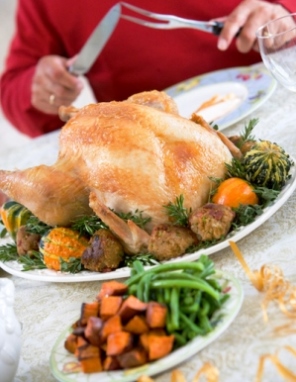When it comes to Thanksgiving, everyone has their own take on what the meal should consist of, but most people can probably agree that the classic holiday meal includes the following: dressing, cranberry sauce, mashed potatoes with gravy, sweet potato casserole, and green bean casserole. The real star of the meal is of course, the turkey.
But have you ever wondered how the turkey became such a huge Thanksgiving staple? Why not pork, or roast beef? A common misconception is that turkey was served at the first Thanksgiving with the Plymouth Colonists and Wampanoag Indians back in the 1600s and the tradition has been passed down through many generations until present day. With the availability of wild fowl in the new Plymouth colony, birds were probably part of the meal, but historians have no clear indication that turkey was specifically a main course at this gathering.
However, as time progressed, and turkey was more readily available in Europe and in the New World, it became more of a household staple for larger meals. In the 1500s and 1600s, Europeans ate all types of fowl, including geese, peacocks, swans, and herons. Turkey was a huge game changer. This was partially due to the fact that other fowl, like geese, was less substantial for feeding bigger crowds. Some birds were also tough to eat, or had a fishy taste based off of their diet before they were prepared. Another perk to serving turkey during the holiday was turkeys had a tendency to be bigger during the fall. During the spring and summer, turkeys were not as plumb because they had less to eat, but gained significant weight by feasting off of nuts and seeds from the fall harvest.
So now that we know about the origins, what about the way a turkey is prepared? During the medieval ages, a common way to prep meat was by boiling or preserving it and then seasoning with herbs and spices. Could you imagine serving a whole preserved turkey to your family and friends for Thanksgiving? Fortunately, an alternative option was to roast the meat. This was typically done only if the meat had plenty of fat, which was the perfect cooking technique for a turkey during the fall.
Sometimes, turkeys were stuffed as well. This is no new concept. Food historians tie stuffing meat back to the Romans and it was commonly practiced during the Medieval Ages. Stuffing, or dressing, depending on where you are from, has the ability to enhance the turkey’s flavor, and could include a variety of food items. During the time of the pilgrims and Indians, fowl was most likely stuffed with whatever they had available, which could include wild grains and nuts. Early Europeans stuffed their birds with a variety of items, including herbs, spices, chopped chestnuts, beef marrow, turkey innards, and bread rolls.
As far as keeping the tradition today, one of the reasons is a health advantage. Turkey not only has a lot of protein, but is also quite lean compared to ham or certain cuts of red meat. Now, throw in all of your sides and your healthy main course option might not make a huge difference, but it’s the thought that counts, right?
Serving turkey for Thanksgiving is also reinforced by pop culture. When you see a movie involving this holiday, what do you see served a majority of the time? Turkey. You can also walk by any magazine food stand during November and you’ll more than likely see a delicious roasted turkey there too. No matter the reason for how the turkey became a fan favorite, I’m glad this big bird made it to our top Thanksgiving staples.
By: Ga Ming Gao




